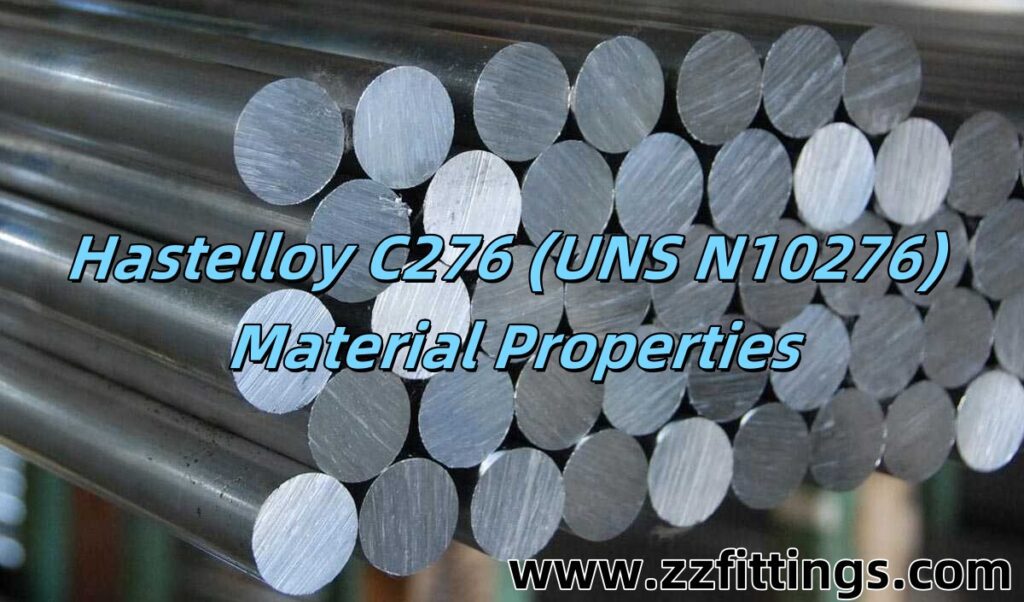Hastelloy C276 (UNS N10276) is a nickel-molybdenum-chromium alloy known for its exceptional corrosion resistance in extreme environments, including strong oxidizers, reducing agents, and high-temperature conditions.

What is Hastelloy C276 material?
Hastelloy C276 is a nickel-molybdenum-chromium alloy with excellent corrosion resistance in severe environments. It is widely used in chemical processing, marine, and pollution control applications due to its exceptional resistance to pitting, crevice corrosion, and stress corrosion cracking.
Key Features
✔ Superior Corrosion Resistance: Highly resistant to a wide range of aggressive chemicals, including oxidizing and reducing agents.
✔ Excellent Pitting and Crevice Corrosion Resistance: Ideal for harsh environments.
✔ Outstanding Stress Corrosion Cracking Resistance: Performs well in chloride-containing environments.
✔ Good Fabricability & Weldability: Can be welded using standard methods like TIG and MIG.
✔ High-Temperature Performance: Maintains mechanical strength in elevated temperatures.
Corrosion Resistance – Hastelloy C276
Hastelloy C276 is one of the most corrosion-resistant alloys available, offering superior protection in highly aggressive environments, including oxidizing, reducing, acidic, and chloride-rich conditions.
1. Types of Corrosion Resistance
✔ Pitting & Crevice Corrosion Resistance
Outstanding resistance to pitting and crevice corrosion, even in highly acidic and chloride-containing solutions.
Performs better than stainless steel (316, 904L, Duplex, Super Duplex) in aggressive environments.
✔ Stress Corrosion Cracking (SCC) Resistance
Highly resistant to chloride-induced stress corrosion cracking (SCC).
Suitable for seawater, chemical plants, and offshore applications.
✔ Uniform Corrosion Resistance
Provides protection in strong acids (HCl, H₂SO₄, HNO₃, H₃PO₄, HF, etc.).
Resistant to both oxidizing and reducing agents, making it more versatile than stainless steels and other nickel alloys.
✔ Intergranular Corrosion Resistance
Low carbon content (C ≤ 0.01%) minimizes carbide precipitation, preventing intergranular attack in welded structures.
Does not require post-weld heat treatment (PWHT).
✔ Resistance to Wet Chlorine & Chlorine Dioxide
Exceptional resistance to chlorine gas, wet chlorine, and chlorine dioxide, making it ideal for chemical and pulp & paper industries.
What is the ASTM standard for Hastelloy C276?
Hastelloy C276 is covered by several ASTM standards, depending on the product form (plates, pipes, tubes, bars, etc.). Below is a list of relevant ASTM specifications:
| Product Form | ASTM Standard | Description |
| Plates, Sheets & Strips | ASTM B575 | Standard for Nickel Alloy Sheet, Strip, and Plate |
| Seamless Pipe & Tube | ASTM B622 | Specification for Seamless Nickel Alloy Pipes & Tubes |
| Welded Pipe | ASTM B619 | Covers Welded Nickel Alloy Pipes |
| Welded Tube | ASTM B626 | Covers Welded Nickel Alloy Tubes |
| Bars, Rods & Forgings | ASTM B564 | Specification for Nickel Alloy Forgings, Bars, and Rods |
| Fittings (Forged/BW) | ASTM B366 | Covers Nickel Alloy Buttweld and Forged Pipe Fittings |
| Wire | ASTM B574 | Covers Nickel Alloy Wire |
Key Notes:
ASTM B575 is the most commonly referenced standard for Hastelloy C276 in plate form.
ASTM B622 & B619 are widely used for seamless and welded pipes, respectively.
ASTM B366 is crucial for fittings like elbows, tees, and reducers.
Hastelloy C276 Chemical Composition
| Element | Nickel (Ni) | Molybdenum (Mo) | Chromium (Cr) | Iron (Fe) | Tungsten (W) | Cobalt (Co) | Manganese (Mn) | Vanadium (V) | Silicon (Si) | Carbon (C) | Phosphorus (P) | Sulfur (S) |
| Composition (%) | Balance (~57%) | 15.0 – 17.0 | 14.5 – 16.5 | 4.0 – 7.0 | 3.0 – 4.5 | ≤ 2.5 | ≤ 1.0 | ≤ 0.35 | ≤ 0.08 | ≤ 0.01 | ≤ 0.04 | ≤ 0.03 |
Hastelloy C276 Physical Properties
| Properties | Metric | Imperial |
| Density | 8.89 g/cm³ | 0.321 lb/in³ |
| Melting point | 1371°C | 2500°F |
Hastelloy C276 Mechanical Properties
| Properties | Metric | Imperial |
| Tensile strength (@thickness 4.80-25.4 mm, 538°C/@thickness 0.189-1.00 in, 1000°F) | 601.2 MPa | 87200 psi |
| Yield strength (0.2% offset, @thickness 2.40 mm, 427°C/@thickness 0.0945 in, 801°F) | 204.8 MPa | 29700 psi |
| Elastic modulus (RT) | 205 GPa | 29700 ksi |
| Elongation at break (in 50.8 mm, @thickness 1.60-4.70 mm, 204°C/@thickness 0.0630-0.185 in, 399°F) | 56% | 56% |
| Hardness, Rockwell B (plate) | 87 | 87 |
Equivalent Grades
| Standard | Equivalent Grade |
| UNS | N10276 |
| ASTM | B575, B619, B622, B626 |
| DIN | 2.4819 |
| EN | NiMo16Cr15W |
What is the grade of Hastelloy material?
1. Common Hastelloy Grades & Their Applications
| Grade | UNS No. | Composition Highlights | Key Features | Applications |
| Hastelloy C276 | N10276 | Ni-Mo-Cr-Fe-W | Best for severe corrosion, pitting, and crevice corrosion resistance | Chemical processing, marine, pollution control, aerospace |
| Hastelloy C22 | N06022 | Ni-Mo-Cr-Fe-W | Improved corrosion resistance over C276, especially against oxidizing acids | Acid processing, pharmaceutical, flue gas scrubbers |
| Hastelloy C2000 | N06200 | Ni-Mo-Cr-Cu | Copper addition for enhanced resistance to sulfuric acid | Chemical processing, pickling, acid manufacturing |
| Hastelloy B2 | N10665 | Ni-Mo | Excellent resistance to hydrochloric acid, but not in oxidizing environments | Hydrochloric acid plants, pickling systems |
| Hastelloy B3 | N10675 | Ni-Mo | Improved thermal stability over B2 | Similar to B2 but better fabricability |
| Hastelloy X | N06002 | Ni-Cr-Fe-Mo | High temperature resistance and oxidation resistance | Aerospace, gas turbines, furnace components |
Is Hastelloy harder than stainless steel?
Hastelloy and stainless steel are both widely used in corrosion-resistant applications, but Hastelloy is generally harder and stronger than most stainless steel grades.
1. Hardness Comparison (Brinell Hardness – HB & Rockwell Hardness – HRB/HRC)
| Material | Brinell Hardness (HB) | Rockwell Hardness (HRC/HRB) |
| Hastelloy C276 | 217 HB | ~89 HRB |
| Hastelloy C22 | 220 HB | ~90 HRB |
| Hastelloy B2 | 200 HB | ~85 HRB |
| Stainless Steel 304 | 123 – 201 HB | ~70–95 HRB |
| Stainless Steel 316 | 149 – 217 HB | ~79–95 HRB |
| Stainless Steel 410 (Hardened) | 207 – 285 HB | 20 – 45 HRC |
Key Takeaways:
Hastelloy C-series (C276, C22) is harder than 304 and 316 stainless steel.
Hastelloy is softer than hardened martensitic stainless steels like 410 & 17-4 PH.
Hastelloy alloys are generally stronger, with superior mechanical properties.
2. Strength & Durability Comparison
| Property | Hastelloy C276 | Stainless Steel 316 |
| Tensile Strength | 759 MPa (110,000 psi) | 515 MPa (75,000 psi) |
| Yield Strength | 283 MPa (41,000 psi) | 205 MPa (30,000 psi) |
| Elongation | 40% | 30% |
| Corrosion Resistance | ✅ Excellent (Superior) | ✅ Good |
Key Takeaways:
Hastelloy has a higher tensile & yield strength than stainless steel.
Better corrosion resistance, especially in harsh environments (acidic, chloride-rich, and high-temperature conditions).
Hastelloy is more expensive but provides longer durability and reliability in extreme environments.
Fabrication and Heat Treatment
HASTELLOY(r) C276 is generally used in the solution treated condition. This alloy is soaked at 1121°C (2050°F) and then quenched in a rapid manner.
Conventional cold working procedures are used for cold working HASTELLOY(r).
HASTELLOY(r) C276 is capable of being welded by the commonly used welding methods. During the welding process excessive input of heat should be avoided. For corrosive applications this alloy is capable of being used in the “as-welded” condition without the need for more heat treatment.
Conventional methods are used to forge or hot-upset HASTELLOY(r) C276.
HASTELLOY(r) C276 can be formed by being cold worked using conventional techniques.
HASTELLOY(r) C276 has good machinability characteristic.
HASTELLOY(r) C276 is solution heat treated at 1121°C (2050°F) and then quenched rapidly. In case of forging or hot forming, the parts should first be solution heat treated before usage.
HASTELLOY(r) C276 is cold worked to be hardened.
Super alloy HASTELLOY(r) C276 is capable of being extruded or hot formed. After the hot forming process, this alloy should be solution heat treated.
Aging is not performed for HASTELLOY(r) C276 that is utilized in a solution treated condition.
You can get an offer for products in below material forms:
-Pipe and Tube (EN 10216-5, ASTM A213, ASTM A249, A312, A790,)
-Forged Fitting and Flange (ASTM A182 , ASTM A105,ASTM B564 )
-Butt Weld Fittings (ASTM A234, ASTM A403,ASTM A815)
-Round bar , Billet (ASTM A276, ASTM A479)
– Plate, Sheet, Strip(ASTM A240, EN 10028-7, A480)
-Bolting, Nuts(ASTM A193, A194, A320)
Hastelloy C276 Material Exported Countries
We Export Hastelloy C276 Material to Saudi Arabia, United Arab Emirates, Qatar, Bahrain, Oman, Kuwait, Turkey, Egypt, Yemen , Syria, Jordan, Cyprus, Singapore, Malaysia, Indonesia, Thailand, Vietnam, South Korea, Japan, Sri Lanka, Maldives, Bangladesh, Cambodia, Argentina, Bolivia, Brazil, Venezuela, Colombia, Ecuador, Guyana, Paraguay, Uruguay, United States Of America, Canada, Mexico, Panama, Jamaica, Bahamas, Denmark, Norway, Germany, France,Italy, United Kingdom, Spain, Belgium, Greece, Czech Republic, Portugal, Hungary, Albania, Austria, Finland, Ireland, Croatia, Malta, Nigeria, Algeria, Angola, South Africa, Libya, Egypt, Sudan, Europe, Africa, Asia, North America, South America, Middle East.etc
